How to Repair a Irrigation Solenoid Valve
When a solenoid valve (also called an electric valve or automatic sprinkler valve) fails to close it is almost always because something is stuck inside it. This might be a grain of sand, a small twig, a insect, or even a tiny snail. To fix the valve you need to disassemble and clean it. When a valve fails to open it is usually due to a bad solenoid or bad wiring, although in rare cases a grain of sand stuck inside the valve or a ripped diaphragm inside the valve. The following instruction tell how to disassemble, clean, and inspect the automatic valve.
To clean the valve:
As you disassemble the valve be sure to note how all the parts fit together so you can get it back together correctly! I strongly suggest you make a sketch and take notes. Each brand and model of valve is slightly different. The valve shown in the photos here is an anti-siphon type valve, which is a type commonly used on home sprinkler systems. The cap structure on the right side of this valve is the anti-siphon device.
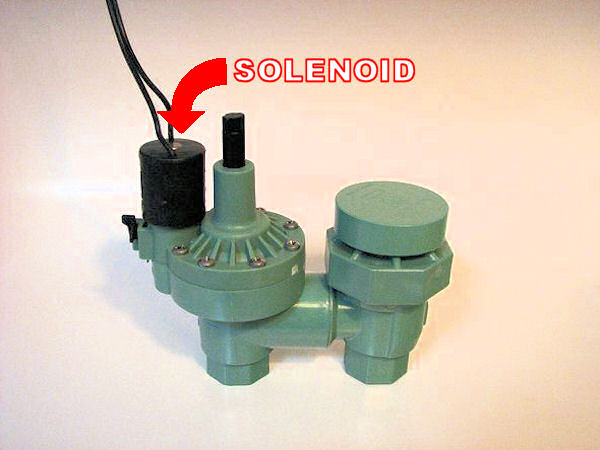
Typical Anti-Siphon Type Solenoid Valve
Remove the solenoid from the valve. Most solenoids unscrew counter-clockwise to remove. When removing the solenoid watch that the spring loaded plunger inside it does not pop-out and fall into a mud puddle. On most newer valves the plunger is held "captive" so it won't fall out when the solenoid is removed, but sometimes even those ones come loose. Once the solenoid is removed, push in on the end of the spring-loaded plunger in the solenoid. It should spring gently back out when released, and it should slide in and out smoothly when pressed several times in a row. If the plunger doesn't move easily and smoothly, replace the solenoid; it is damaged and can't be repaired. Do not apply any oil or lubricant to the solenoid plunger, if it is sticking it is not repairable, replace it.
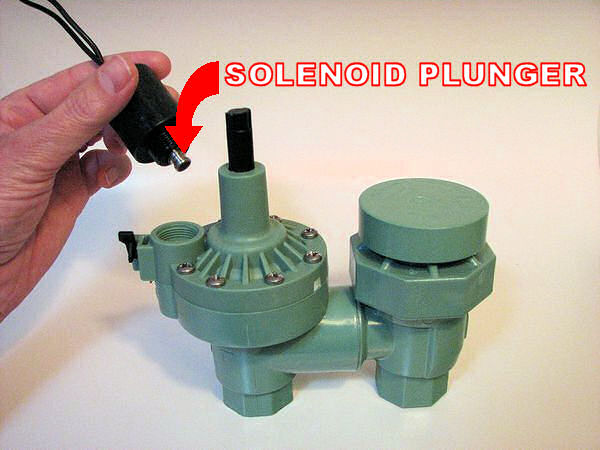
Solenoid Removed, Showing Plunger
Remove the valve lid, most are held in place by several metal screws. Some models of valve have lids that screw off like the top of a jar, turn counter-clockwise (lefty losey) to remove this type of lid. You may need to use a strap wrench to remove the jar-top style lids. All valves have a spring under the lid, don't let it fall out into the mud! Remove the spring and set it aside.

Valve Lid Screws
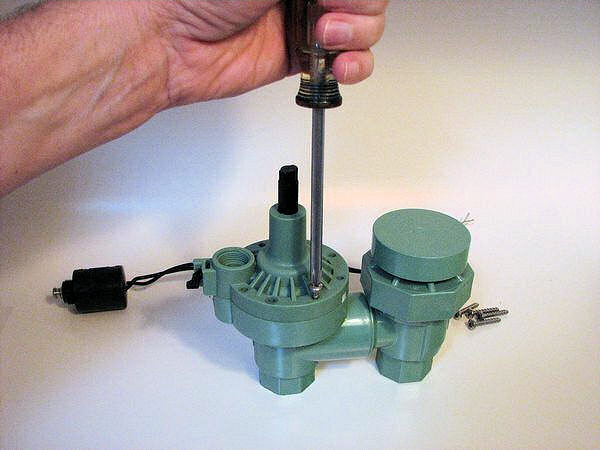
Removing Valve Lid Screws
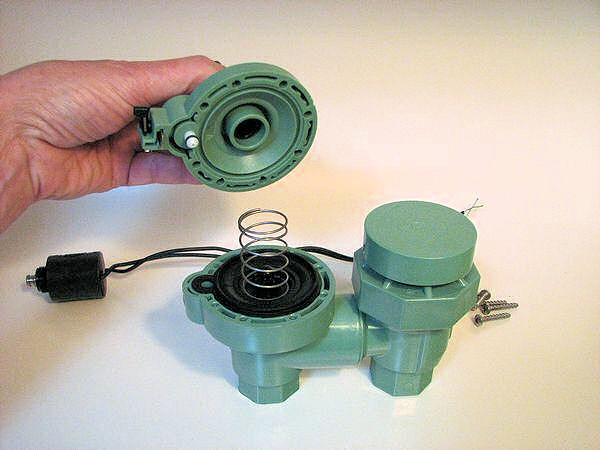
Watch that the Spring Does Not Fall Out When Removing the Lid
Look for the tiny passages, called "ports", inside the valve lid. These ports lead from the bottom of the lid to the area where the solenoid was attached. The exact location of the ports varies with each valve brand and model. Make sure these passages are not clogged with a grain of sand or whatever. Be careful you do not scratch or enlarge these passages when trying to get the sand out! Do not try to drill out these ports to clean them or make them larger.

Ports in Lid
Remove the rubber diaphragm from the valve. Make sure it is not cracked or broken, if it is replace it. Some valve models also have a port in the diaphragm, check to see if there is one, if so make sure it is clean. On some valves the port in the diaphragm has a metal pin that runs through it, the purpose of the pin is to keep the port clean. The pin should slide freely in the port. The diaphragm in the photo below has a separate, removable seat gasket attached to the bottom of it with a screw. On many valves the rubber seat gasket and the diaphragm are one piece and the seat gasket is not removable. Make sure the seat gasket or diaphragm seat does not have anything stuck on it, like a grain of sand or twig. If the gasket surface is scratched or torn replace the gasket or diaphragm.
Examine the valve seat in the bottom of the valve body. The seat is the part of the valve body that the gasket presses against to stop the water flow through the valve. Make sure the seat is not scratched or pitted, if it is the valve will leak when closed. On some valves the seat is replaceable. On some brass valves the seat can be ground down with a special tool to remove pits and scratches. However, for most valves if the seat is scratched or pitted, the valve is not repairable and must be replaced.
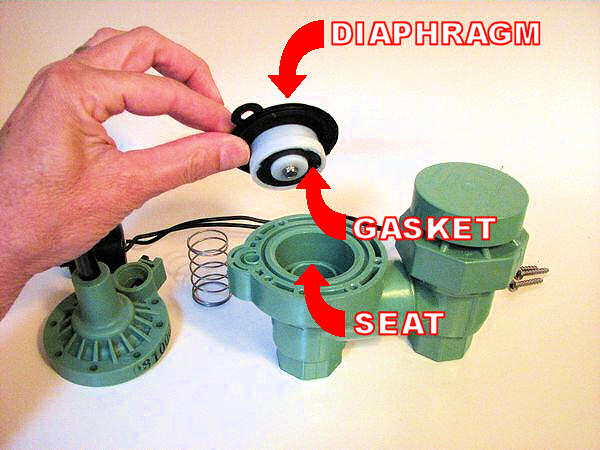
Rubber Diaphragm and Gasket
With the valve disassembled turn on the water to flush any remaining sand and crud from the pipes upstream of the valve. Turn it on full blast, and run it for a minute or two, you need to get everything out of that pipe. Turn off the water, and dry yourself off. I know you don't want to get wet, but don't skip flushing the pipes and valve body, this is an important step!
Carefully clean everything, then reassemble the valve. Some valves have a separate lid gasket or o-ring that needs to be cleaned or replaced before being reassembled. If there are any o-rings, I strongly suggest you lubricate them before reassembling using K-Y Jelly or a similar product. Lubricating o-rings is optional, but recommended as it keeps them from crimping during assembly. If the o-ring crimps it will be ruined and will leak. K-Y Jelly is a water-based lubricant that you buy in the feminine hygiene department of a supermarket or drug store. (Don't ask for it at the hardware store unless you want to give the employees a good laugh at your expense. Yes, I admit I fell for this back when I was first starting out in this business, it's a favorite plumber gag to send the new guy out to buy the K-Y Jelly!) Do not use vaseline, silicone, oil or any petroleum based products on the valve, they may damage the seals and also may clog the ports in the valve.
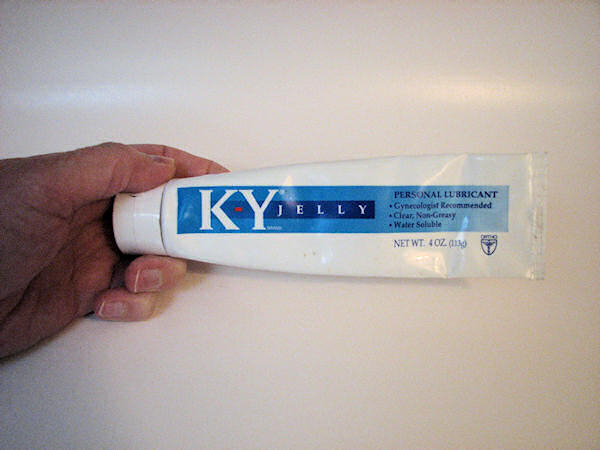
Use K-Y Jelly to Lubricate Rubber Parts of the Valve
Do Not Use Petroleum-Based Products!
When attaching the lid, avoid striping out the lid threads and warping the lid as follows: When inserting the screws that hold the cap on, start with one of the screws next to the solenoid. Insert the screw in the hole then turn it counter-clockwise (losey lefty) until you feel a slight click as the screw finds the threads. Then reverse direction (righty tighty) and lightly tighten it. Then insert the second screw on the opposite side of the valve lid. Like the first, find the threads then just lightly tighten the screw. Continue with one screw on one side and the next on the other until they are all in. Now go back and tighten them all, going in the same order you inserted them. Do not over-tighten the screws on plastic valves, you will strip out the threads.
If you're blessed and didn't mess up something the valve should work correctly now.
Suggestion: Your valve has already failed once, chances are that means something in the water got stuck in it, which means there is sand or whatever in the water supply. Consider installing a filter upstream of the valve to keep out the sand and crud in the future. Typically the cost of a valve repair is greater than the cost of installing a filter. See the Irrigation Water Filtration Tutorial.